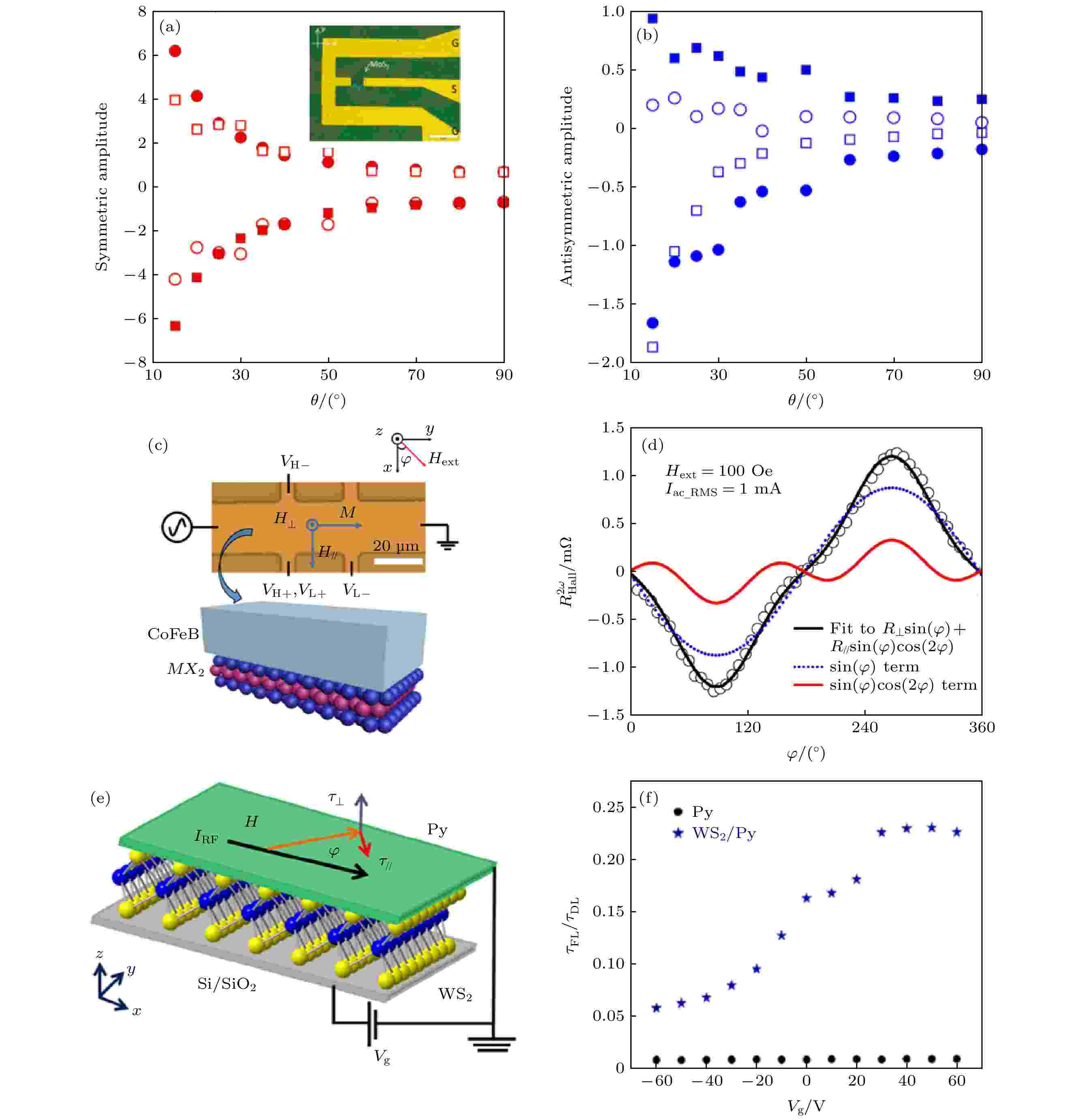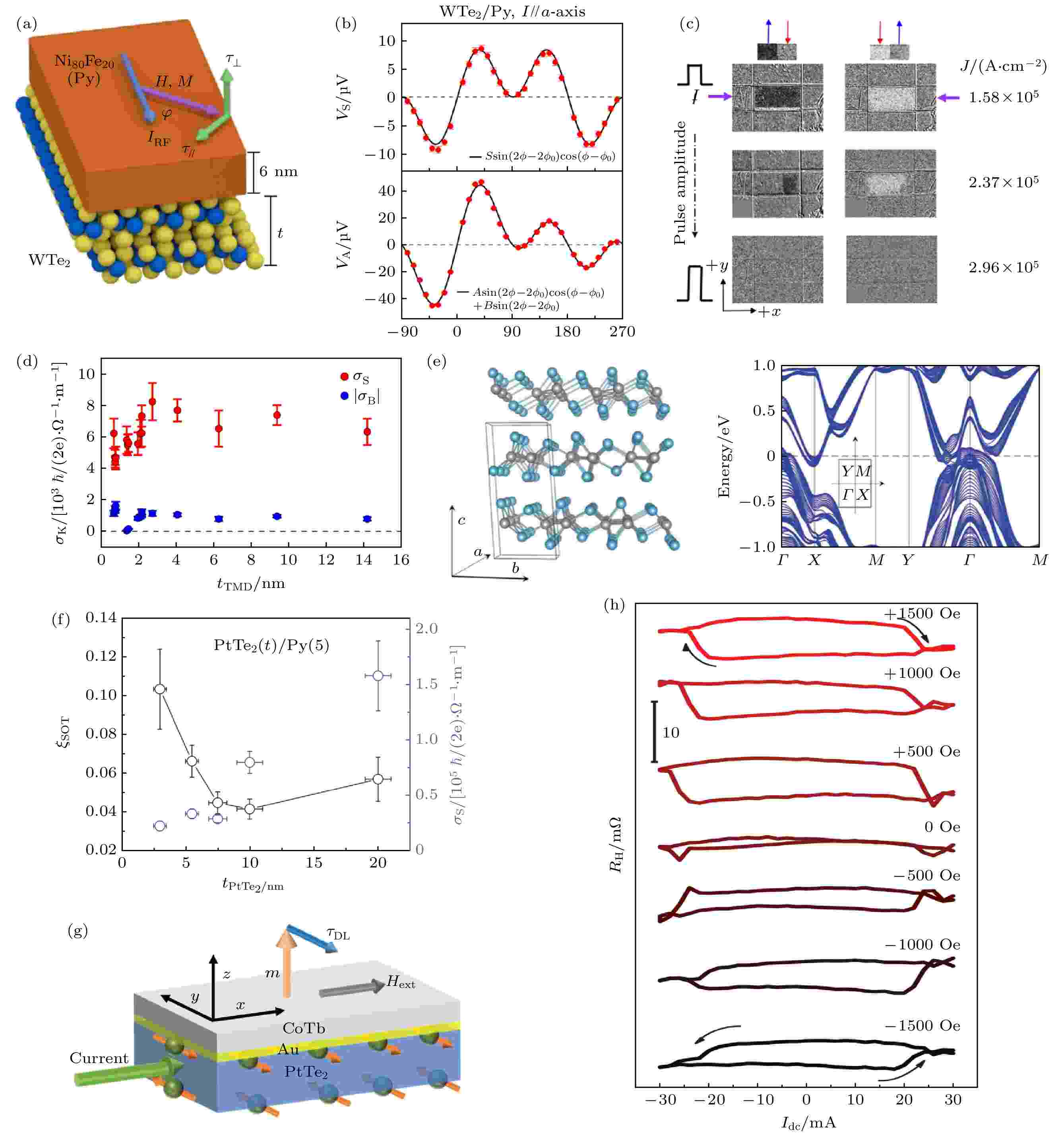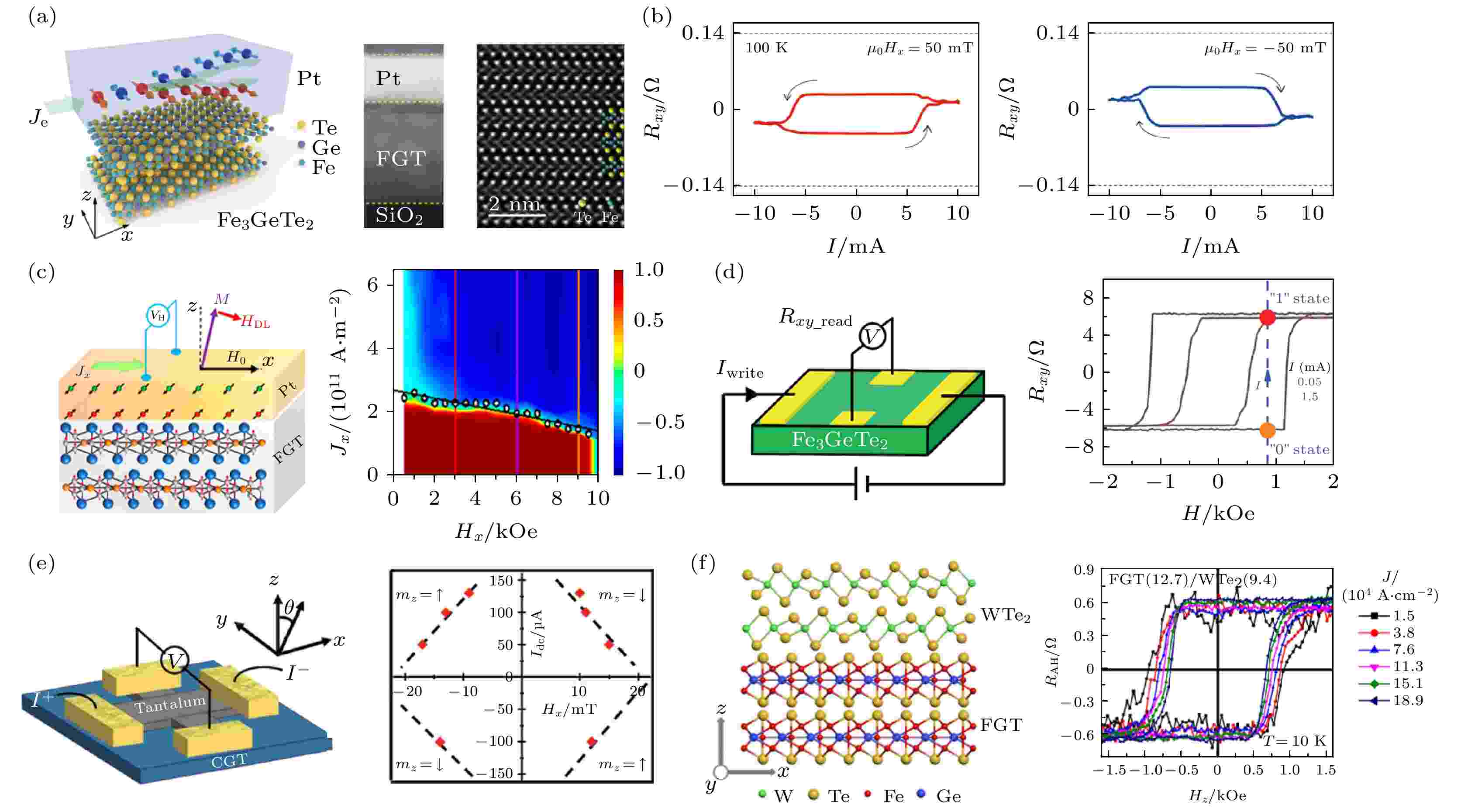全文HTML
--> --> -->近年来, 利用SOT驱动磁矩翻转的相关研究备受关注[4-27], 并且研究内容不断扩展到很多研究方向, 包括磁畴壁运动、磁斯格明子运动、自旋逻辑器件、反铁磁磁矩操控、自旋神经形态器件及铁磁共振等[28-47]. 目前, 相关研究中用于产生SOT的材料主要集中于重金属, 如Pt, Ta, W等. 通过开发新材料、发现新物理以提高SOT器件的各方面的性能是相关研究的重要目标. 受层状拓扑绝缘体(如Bi2Se3等)在SOT方面研究进展的影响, 基于二维材料的SOT器件研究逐渐引起了人们的关注[48-52]. 新兴的二维晶体和拓扑材料由于具有众多的优点, 如种类丰富、具有多样化的晶体结构和对称性、能够克服晶格失配形成高质量的异质结、具有强自旋-轨道耦合、电导率可调等, 为自旋电子学研究提供了理想的物理研究平台[52-57]. 例如, 二维过渡金属硫族化物(transition-metal dichalcogenides, TMDs)材料WTe2具有低对称性结构和强的SOC, 除了能够产生传统的自旋取向沿面内的自旋流外, 还可以产生自旋取向沿面外的自旋流, 进而诱导产生非传统的SOT, 理论上可以在无外磁场辅助的条件下直接翻转垂直磁矩[58]. 因此, 探索二维材料异质结中的SOT、电流驱动磁矩翻转及相关自旋电子器件有非常重要的意义.
本文首先总结了非磁性二维材料异质结中SOT效应研究的最新实验进展; 然后介绍了磁性二维材料异质结中SOT的表征和驱动磁矩翻转相关的工作; 最后, 简单地讨论一下未来将二维材料用于自旋电子器件所面临的问题和挑战, 并进行了总结和展望.


| TMD材料 | 空间群 | 制备方法 | 表征方法 | 自旋霍尔电导$/[{10}^{3}({\hbar /2{\rm{e}}} )$ (Ω·m)–1] | 文献 |
| MoS2 | P6/mmc | CVD | SHH | $ {\sigma }_{\rm{A}}= $ 2.9 | [60] |
| WSe2 | P6/mmc | CVD | SHH | $ {\sigma }_{\rm{A}}= $ 5.5 | [60] |
| WS2 | P6/mmc | CVD | SHH | $ {\sigma }_{\rm{A}}, {\sigma }_{\rm{S}} $ observed | [61] |
| WTe2 | Pmn21 | Exfoliation | ST-FMR/SHH | $ {\sigma }_{\rm{A}}= $ 9 ± 3, $ {\sigma }_{\rm{S}}= $ 8 ± 2, $ {\sigma }_{\rm{B}}= $ 3.6 ± 0.8 | [58] |
| WTe2 | Pmn21 | Exfoliation | ST-FMR/SHH | $ {\sigma }_{\rm{A}}, {\sigma }_{\rm{S}} $, ${\sigma }_{\rm B}$ observed | [62] |
| TaTe2 | C2/m | Exfoliation | ST-FMR/SHH | $ {\sigma }_{\rm{A}}, {\sigma }_{\rm{S}} $, ${\sigma }_{\rm B}$ observed | [64] |
| MoTe2 | P21/m | Exfoliation | ST-FMR | ${\sigma }_{\rm{S} }=4.4 —8.0,$ ${\sigma }_{\rm{B} }=0.04—1.6,$ ${\sigma }_{\rm{T} }=0.026—1.0$ | [65] |
| NbSe2 | P63/mmc | Exfoliation | ST-FMR | ${\sigma }_{\rm{A} }=0— 40,$ ${\sigma }_{\rm{S} }=0— 13,$ ${\sigma }_{\rm{T} }=- 2—3.5$ | [66] |
| PtTe2 | — | CVD | ST-FMR | ${\sigma }_{\rm{S} }=0.20—1.6\times {10}^{2}$ | [68] |
| TaS2 | — | Ion-beam sputtering | ST-FMR/SHH | $ {\sigma }_{\rm{S}}=14.9\times {10}^{2} $ | [69] |
表1已报道的实验研究工作中TMD材料的晶体结构、制备方法、TMD/FM异质结中的SOT的表征方法以及自旋霍尔电导
Table1.Crystal structure, preparation method, method for SOT measurement of the TMD/FM heterostructure, and spin Hall conductance of TMD materials in the previous studies.
2
2.1.二维半导体材料
2H-MoS2是一种二维半导体材料, 因具有宽能隙和高迁移率等特性而备受关注. 它具有六角晶格结构, 每个Mo原子与6个最近邻S原子结合, 属于P6/mmc空间群. 单层MoS2与FM层接触时, 由于界面对称性的破缺, 电流能够诱导产生类阻尼SOT






 图 1 MoS2/Py异质结中ST-FMR信号的对称(a)和反对称(b)振幅随外加磁场与平面夹角θ的依赖关系(插图为基于MoS2/Py异质结的ST-FMR器件光学显微镜图)[59]; (c) MX2/CoFeB 异质结的SOT测量装置示意图; (d) 二次谐波方法测得二阶霍尔电阻与φ的函数关系, 外加磁场为100 Oe (1 Oe = 103/(4π) A/m)[60]; (e) WS2/Py双层器件几何结构示意图, 其中Vg通过SiO2介质层施加; (f)Vg对Py和WS2/Py双层的转矩比
图 1 MoS2/Py异质结中ST-FMR信号的对称(a)和反对称(b)振幅随外加磁场与平面夹角θ的依赖关系(插图为基于MoS2/Py异质结的ST-FMR器件光学显微镜图)[59]; (c) MX2/CoFeB 异质结的SOT测量装置示意图; (d) 二次谐波方法测得二阶霍尔电阻与φ的函数关系, 外加磁场为100 Oe (1 Oe = 103/(4π) A/m)[60]; (e) WS2/Py双层器件几何结构示意图, 其中Vg通过SiO2介质层施加; (f)Vg对Py和WS2/Py双层的转矩比
Figure1. Out-of-plane (OOP) angular (the applied field is described by the polar angle) dependence of symmetric (a) and antisymmetric (b) components of the ST-FMR signal based on MoS2/Py heterostructure (the inset is photo image of ST-FMR device)[59]; (c) measurement setup of SOT measurements for the MX2/CoFeB bilayer; (d) second-harmonic Hall resistance as a function of φ with an external magnetic field 100 Oe applied[60]; (e) schematic of the WS2/Py bilayer device geometry, where Vg was applied through the SiO2 dielectric layer; (f) torque ratio

Lv等[61]采用ST-FMR技术研究了1L-WS2/Py(10 nm)异质结构中的SOT (图1(e)). 样品中WS2和Py薄膜分别通过CVD方法和电子束蒸发方法制备. 实验观察到了类阻尼SOT和类场SOT, 其主要物理起源被归因于界面Rashba-Edelstein效应. 这个实验再次证明了利用单层TMD材料能够产生SOT. 更重要的是, Lv等[61]还证明栅压可以调控TMD材料所产生的SOT (图1(f)). 当施加栅压从–60 V到60 V,

2
2.2.二维(半)金属材料
除了半导体TMD材料之外, (半)金属TMD材料也被广泛地研究. 研究这类材料的主要驱动力在于它们具有高导电性、强自旋-轨道耦合、低结构对称性等. 人们最早研究的(半)金属TMD材料是WTe2, 属于Pmn21空间群. 同MoS2相比, 它具有更低的对称性, 满足产生非传统SOT的对称性要求. MacNeill等[58]首次利用ST-FMR技术研究了WTe2/Py异质结构中的SOT, 如图2(a)所示. 除了传统的类场SOT和类阻尼SOT, 实验还观察到了非传统的面外SOT (图2(b)), 其对应的自旋霍尔电导为
 图 2 (a) WTe2/Py异质结样品几何结构示意图; (b) WTe2/Py器件的对称和反对称ST-FMR信号与面内磁场角度的依赖关系, 其中电流平行于a轴[58]; (c) 由MOKE图像捕捉到的电流驱动磁矩翻转过程[62]; (d) 自旋电导率随MoTe2厚度的变化关系[65]; (e) MoTe2单斜1T′相的晶体结构和20层MoTe2薄膜的能带结构[70]; (f) PtTe2/Py器件ST-FMR测量SOT效率ξSOT和自旋霍尔电导率
图 2 (a) WTe2/Py异质结样品几何结构示意图; (b) WTe2/Py器件的对称和反对称ST-FMR信号与面内磁场角度的依赖关系, 其中电流平行于a轴[58]; (c) 由MOKE图像捕捉到的电流驱动磁矩翻转过程[62]; (d) 自旋电导率随MoTe2厚度的变化关系[65]; (e) MoTe2单斜1T′相的晶体结构和20层MoTe2薄膜的能带结构[70]; (f) PtTe2/Py器件ST-FMR测量SOT效率ξSOT和自旋霍尔电导率
Figure2. (a) Schematic of the bilayer WTe2/Py sample geometry; (b) symmetric and antisymmetric ST-FMR resonance components for a WTe2 (5.5 nm)/Py (6 nm) device as a function of in-plane magnetic-field angle, with current applied parallel to the a-axis[58]; (c) switching process captured by MOKE images[62]; (d) spin conductivities as a function of the thickness of MoTe2, where σS stands for the conventional damping-like torque, σB stands for the out-of-plane damping-like torque, and σT stands for the out-of-plane field-like torque[65]; (e) crystal structure of the monoclinic 1T′ phase of MoTe2 and band structure of a MoTe2 slab with 20 monolayers[70]; (f) thickness dependence of ξSOT and spin Hall conductivity σs of PtTe2/Py measured by ST-FMR; (g) schematic layout for PtTe2/Au/CoTb stack and the SOT generated by the majority of current flowing in PtTe2; (h) current-induced switching of the CoTb layer by SOT from PtTe2 under different in-plane field[68].
因为低对称性是允许产生非传统面外SOT的前提条件, 后续一些实验重点针对具有低对称性的TMD材料展开. MoTe2属于P21/m空间群, 满足产生面外τDL的对称性要求. Stiehl等[65]采用ST-FMR技术研究了β相MoTe2/Py体系中的SOT, 传统的和非传统的SOT同时被观察到. 实验发现, 除了原因尚不清楚的2层MoTe2外, 面内和面外SOT对应的自旋电导都没有明显的厚度依赖性(图2(d)), 揭示了MoTe2/Py体系中SOT的界面起源. Liang等[70]同样研究了1T′-MoTe2/Py异质结中的SOT, 但并未发现面外SOT, 暗示了面外SOT起源的复杂性. 该实验重点集中于室温零磁场下的电流驱动磁矩翻转, 翻转电流比传统重金属材料(例如Pt)要小一个数量级. 实验还研究了该体系中的SOT效率. 对于其研究的最薄厚度为66.1 nm的MoTe2器件, 其SOT效率(ξSOT)约为0.35, 比Ta (~0.15), Pt (~0.06)都要大很多. 翻转电流随MoTe2厚度的增大而增大, SOT效率呈现了随着MoTe2厚度增大而降低. 能带结构计算结果(图2(e))表明, 除了考虑体自旋霍尔效应外, 还需要考虑界面Rashba-Edlstein的贡献. 此外, 他们还设计了哑铃形的异质结磁性器件, 翻转电流进一步降低了60%之多. 这些发现展示了MoTe2等半金属二维材料在低功耗自旋电子器件领域的应用前景.
上面两个关于MoTe2的实验对比说明了非传统面外SOT的起因可能是比较复杂的, 这个结论进一步被TaTe2和NbSe2的实验研究所印证[64]. TaTe2属于C2/m空间群, 同样满足非传统SOT对称性的要求. 但Stiehl等[65]在TaTe2/Py异质结构中并未发现面外SOT, 只观察到了具有Dresselhaus对称性的SOT. 该SOT起源于TaTe2中各向异性的电导率导致的面内横向电流分量产生的奥斯特场. 在WTe2/Py双层膜中也有类似的影响. 除了常规奥斯特转矩和Dresselhaus型转矩外, 并未观察到非传统的SOT, 这可能是由于TaTe2中SOC较弱. 同时Stiehl等[65]也论证了低对称性晶体中面内的各向异性电导率对体系中SOT的重要影响. Guimaraes等[66]采用ST-FMR研究了NbSe2/Py双层膜中电流诱导的SOT. NbSe2具有属于P63/mmc空间群的六边形结构, 与MoS2类似, 其对称性是禁止产生非传统SOT的. 然而, 除了预期的SOT分量外, 他们依然观察到了非传统的SOT. Guimaraes等[66]将产生的非传统SOT归因于器件加工过程中引起的应变效应, 这种应变效应破坏了旋转对称性, 允许产生非传统SOT. 该结果表明除了晶格结构对称性之外, 与界面质量、局部原子点群对称性相关的其他微观因素也可能对诱导产生非传统SOT起到重要作用.
上面提到的实验主要集中于探索非传统面外SOT、开发具有大自旋霍尔角且高导电性的TMD材料. 这些研究主要基于机械剥离的实验方案, 该方法制备样品的产率较低. 如何制备具有大自旋霍尔角且高导电性的大面积TMD材料, 也是将TMD材料用于器件的关键. 最近, Xu等[68]成功制备了大面积、高质量、厚度可控的PtTe2薄膜并且首次研究了这种第二类狄拉克半金属的SOT效应. 该PtTe2薄膜在室温下具有高导电性(约为106 S/m). 因为PtTe2在大气环境中相对稳定, 均匀、平整、大面积的PtTe2薄膜可转移到磁控溅射设备中制备自旋电子器件. 通过对PtTe2/Py异质结进行系统性的ST-FMR测量发现PtTe2薄膜具有较大的类阻尼SOT: 忽略界面自旋的损失, 5 nm厚的PtTe2的自旋霍尔角在0.09—0.15范围, 是对照实验中4 nm厚Pt的1.5—2倍. 从PtTe2中SOT效率随厚度非单调变化的实验结果(图2(f))可以推测PtTe2产生的SOT具有块体态与表面态两个不同的来源. 由于PtTe2的高导电性以及较大的自旋霍尔角, 可实现非常高的自旋霍尔电导率, 达

除了上述方法外, Husain等[69]采用离子束溅射的方法制备了大面积单层TaS2材料, 并采用ST-FMR和二次谐波霍尔测量手段, 研究了TaS2/Py异质结构中的SOT. 在这种异质结构中, 观察到了相当大的类场SOT和类阻尼SOT. 其中, 自旋霍尔角为0.25 ± 0.03, 自旋霍尔电导率14.9 × 105

将vdW材料用于构建自旋电子器件关键的挑战在于如何有效地操控其磁矩, 实现从一种状态到另一种状态的转换. 国内外两个研究团队几乎同时报道了FGT/Pt异质结中的高效SOT及电流驱动翻转方面的重要进展(图3(a)—(c))[88,89]. 当电流在重金属Pt中流动时, 会产生自旋电流并注入磁性FGT中, 利用该自旋流可以有效地操控少层磁体FGT的磁矩方向. 图3(b)展示了FGT在面内磁场分别为Hx = 50和–50 mT的辅助下, 温度为100 K时的电流驱动磁化翻转. FGT的磁化通过电流扫描从一种状态切换到另一种状态. 正(负)面内磁场的翻转极性为逆时针(顺时针), 表明Pt的自旋霍尔角为正, 与之前报道的研究工作一致. 值得注意的是, SOT操控所实现的两个电阻状态并不是完全饱和的(饱和态由图3(b)中虚线表示), 该现象被归因于电流导致的热效应. 研究人员还利用谐波测量进一步定量表征了SOT有效磁场, 并以此为依据估算了少层FGT的饱和磁化强度的上限, 该值比块体材料的饱和磁化强度小一个量级. 除Pt诱导产生SOT外, 最近的研究表明电流在每一个单层的FGT中也会产生局域SOT[90], 并能够对FGT的矫顽场产生有效的调制(图3(d)). 同时利用重金属中产生的SOT和FGT中的局域SOT, 将有利于进一步降低翻转FGT磁矩的电流密度. 上述有关电流操控FGT磁矩所取得的进展进一步推动探索更多vdW磁性材料在自旋电子学器件中的应用.
 图 3 FGT/Pt双层器件的示意图(a)和SOT驱动的垂直磁矩翻转(b)[88]; (c) SOT驱动FGT磁矩翻转有效翻转电流随施加面内磁场的变化[89]; (d) 基于FGT的磁存储器件原理图及电流诱导的矫顽场大幅度降低, 从而降低写入电流密度[90]; (e) 基于CGT/Ta异质结Hall器件的原理图和4 K温度下施加流过Ta的电流Idc和平面内磁场Hx组合时的磁矩mz相图[91]; (f) FGT/WTe2双层结构的原子示意图和不同电流密度下FGT/WTe2 霍尔条在10 K垂直磁场下的反常霍尔电阻[92]
图 3 FGT/Pt双层器件的示意图(a)和SOT驱动的垂直磁矩翻转(b)[88]; (c) SOT驱动FGT磁矩翻转有效翻转电流随施加面内磁场的变化[89]; (d) 基于FGT的磁存储器件原理图及电流诱导的矫顽场大幅度降低, 从而降低写入电流密度[90]; (e) 基于CGT/Ta异质结Hall器件的原理图和4 K温度下施加流过Ta的电流Idc和平面内磁场Hx组合时的磁矩mz相图[91]; (f) FGT/WTe2双层结构的原子示意图和不同电流密度下FGT/WTe2 霍尔条在10 K垂直磁场下的反常霍尔电阻[92]Figure3. Schematic view (a) and SOT-driven perpendicular magnetization switching (b) in the FGT/Pt bilayer device[88]; (c) current-induced magnetization switching of FGT and effective switching current as a function of applied in-plane magnetic field[89]; (d) schematic of FGT-based magnetic memory device and the current-induced substantial reduction of the coercive field and then reduction of the write current[90]; (e) schematic of a fabricated Hall bar device from a CGT/Ta heterostructure and phase diagram of mz for applied combinations of Idc and Hx at 4 K[91]; (f) atomic schematic view of FGT/WTe2 bilayer structure and anomalous Hall resistance of the FGT/WTe2 Hall bar under a perpendicular magnetic field at 10 K with various current densities[93].
近期, Ostwal等[91]和Gupta等[92]分别进行了通过SOT对vdW铁磁体CGT中磁矩调控的研究. Ostwal等[91]在CGT/Ta异质结构中(图3(e)), 施加平面内磁场和流过Ta (一种表现出巨大自旋霍尔效应的重金属)的电流组合, 在面内磁场为20 mT时, 用低至5 × 105 A/cm2的电荷电流密度实现了CGT的磁矩翻转. 该电流密度比翻转非层状金属铁磁体CoFeB等所需的电流密度低两个数量级. 这些结果显示了二维磁性材料未来应用于自旋电子器件的巨大潜力.
到目前为止, 大多数的工作主要集中于范德瓦耳斯材料与传统的金属材料构成的异质结中的SOT研究. 未来, 探索利用全二维材料SOT器件将成为一个重要的研究方向. Shao等[93]已经进行了初步的尝试, 研究了FGT/WTe2双层vdW异质结构中的反常霍尔效应(图3(f)). 在这种器件中, 电流可以有效地调节FGT薄片的矫顽力, 主要归因于FGT/WTe2双层界面热导较低而产生焦耳热效应. 虽然该实验没有实现SOT驱动磁矩的翻转, 但阐明了选择热性能好的二维材料来提高界面热导是非常重要的, 为进一步实现具有性能优良的全二维自旋电子器件提供了思路.
1)二维材料中非传统SOT的微观物理机制仍不清楚. 目前实验所观测到的非传统SOT不能用我们所熟悉的自旋霍尔效应或界面Rashba-Edelstein效应解释, 背后的物理机制仍有待探究. 进一步从理论上阐明非传统SOT的产生机制将有助于找到提高其强度的方法, 促进非传统SOT在操控垂直磁矩方面的应用. 值得指出的是, 利用二维材料谷霍尔效应[94-96]也有可能产生垂直极化的自旋流, 有望用于产生垂直SOT[97].
2)磁性二维材料的居里温度需要进一步提高. 虽然磁性二维材料在一些方面展现出了优势, 但目前大多数磁性二维材料的居里温度都在室温以下, 极大地限制了其在自旋电子器件中的应用. 如何进一步提高居里温度是磁性二维材料相关的物理研究的重要方向, 也是其是否能够用于自旋电子器件的关键. 目前, 一些研究已经报道了相关的技术方案, 能够将已有的磁性二维材料的居里温度提高, 如利用离子液体进行电场调控[73]、利用微结制备方式[98]、界面反铁磁诱导[99]、Ga离子注入[100]等方式. 此外, 不断探索更多的磁性低维材料也是寻求实现高居里温度的关键[101-103].
3)晶圆级二维材料的制备. 虽然通过机械剥离制备的二维材料具有很高晶体质量, 但由于样品尺寸小, 无法实现大规模生产制备. 生长二维晶体材料的常用方法: 分子束外延、化学气相沉积、金属有机化学气相沉积和磁控溅射. 在晶圆尺度上确保二维材料的单晶度和均匀性是至关重要的. 最近的一些研究进展为解决这个问题提供了一些思路. 例如, Zhang课题组[104-106]一直致力于采用CVD方法实现TMD二维材料的高质量晶圆级生长; Xu等[68]通过CVD两步法成功制备了大面积、高质量、厚度可控的PtTe2薄膜; Liu等[107]和Wang等[108]则利用分子束外延实现晶圆级二维FGT材料的制备. Zheng等[109]和Guo等[110]证实了可采用磁控溅射方法制备大面积的超薄拓扑绝缘体材料. 这些工作为获得尺寸可控、规模化、均匀的可集成化二维材料的制备提供了重要的思路.
4)与现有半导体技术的集成. SOT器件能大规模应用, 需要使用后端工艺与现有的标准CMOS技术集成. 在该工艺中, 二维材料需要集成在非晶或多晶衬底(如氧化硅)上. 即使有缓冲层, 高质量二维材料直接生长在非晶或多晶衬底上目前仍是一个很大的挑战. 可以采取转移大规模的二维材料到非晶或多晶衬底上, 而转移加工过程中如何保证二维材料的高质量及稳定性也是目前需要解决的重要课题. 高质量界面有利于自旋传输, 对于获得大的SOT至关重要, 因此实现高质量干净界面也是目前这一领域亟待解决的技术加工问题.
解决上述几方面的挑战是未来二维材料在自旋电子器件中应用的关键, 有可能成为未来几年自旋电子学领域重点关注的方向, 需要物理、材料、半导体领域科学工作者的共同努力和不断探索. 除此之外, 基于二维材料的其他自旋相关效应, 如磁电阻效应、自旋注入、自旋泵浦、反铁磁翻转、自旋振荡、磁畴壁和斯格明子电流操控、自旋热电效应等, 均有待进一步地深入研究探索, 也有望推动发现新的物理现象, 催生新的研究方向.
